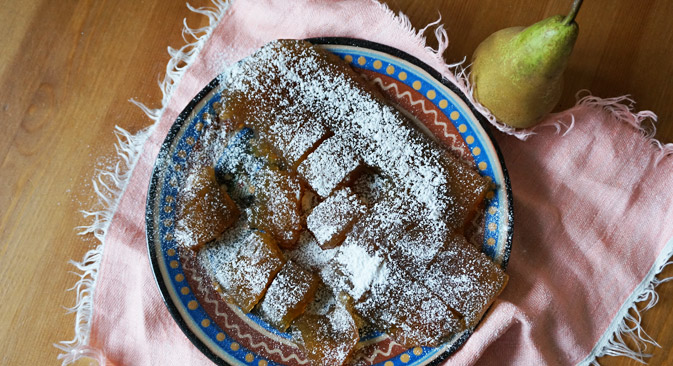
Apple marmalade. Source: Anna Kharzeeva
This piece is part of the Soviet Diet Cookbook, a blog about a modern Russian girl cooking Soviet food. To read more of the series, click here.
I really like the idea of eating seasonal food. Unfortunately, having grown up in a big city and knowing rather little about agriculture, I’m used to eating anything anytime – with some exceptions, of course, like berries and watermelon. Apples are amazing in September – I love the sour Russian varieties, and autumn is the season that everyone with a dacha is trying to use up their apples and give them away to friends, family, neighbors and colleagues – sometimes even strangers.
But I recently made apple and pear marmalade, although it's late spring, and I know I should feel ashamed, but it tastes too good and I just feel happy instead – having the whole summer ahead helps, too.
I should also explain that what we call marmalade is more like jelly candy and not jam. The homemade type is less settled than the gelatin-based ones from the shop, although I’m not speaking from a great depth of experience — before thie experiment, I’d never had homemade marmalade before.
My grandmother tells me that back in the day there were state “cooperatives” that would drive around to people’s dachas during apple season and buy apples from them to make jam, juice and marmalade. The buying price was low, but people were happy to get rid of the excess fruit. And still there was enough left over to make jam, and even nalivka – a homemade fruit-based alcoholic drink – and wine.
I remember the first time I ever tried alcohol was at granny’s place: my great-grandmother, Mun’ka, had made cherry nalivka and I licked some off a spoon. It was sweet and really yummy to a teenager, and it took me a while to develop a taste for dry wines afterwards… it was worth the struggle though!
Mun’ka also used to make nalivka from grapes and other fruit. She would put a 3-liter jar with fruit and sugar in it on the windowsill by the sun and just leave it there for a month. She would then strain the liquid – and voila, the nalivka was ready! I remember Mun’ka would always demand a glass of wine (the size of a thimble) at every celebration, even when she was over 100 years old.
Granny says everyone made nalivki at home, and there was a famous type called “my grandmother’s bouquet” which just included absolutely all the unwanted fruit in the house. In season, fruit and berries were very cheap and even if you didn’t have a dacha, you could get plenty at the market. These days, it’s cheaper to buy ready-made alcohol than to buy enough fruit and berries to make your own. It’s a shame fruit is expensive, but I’m so grateful we have decent wines to choose from! Some people still make rowan tree “wine” at home. It’s supposed to be ‘good for you’ — like normal wine isn’t!
This summer I might try making a nalivka — I can already imagine my husband’s face when he sees the big glass jar taking up space on the windowsill. I’ll have to make plenty of marmalade to soften the blow for him, and I’ll probably have a helping or two as well.

The recipe from the Soviet Cook Book, page 300
500 grams apples;
400 grams sugar
Wash and cut each apple in half. Remove the core, and then bake in an oven. After baking, rub through a sieve. Into this puree, add the sugar. Mix well.
Cook over medium heat, stirring, until thick – 5-10 minutes. Remove from heat, but before mix cools complete, form into the shape or a pie or cake.
All rights reserved by Rossiyskaya Gazeta.
Subscribe
to our newsletter!
Get the week's best stories straight to your inbox